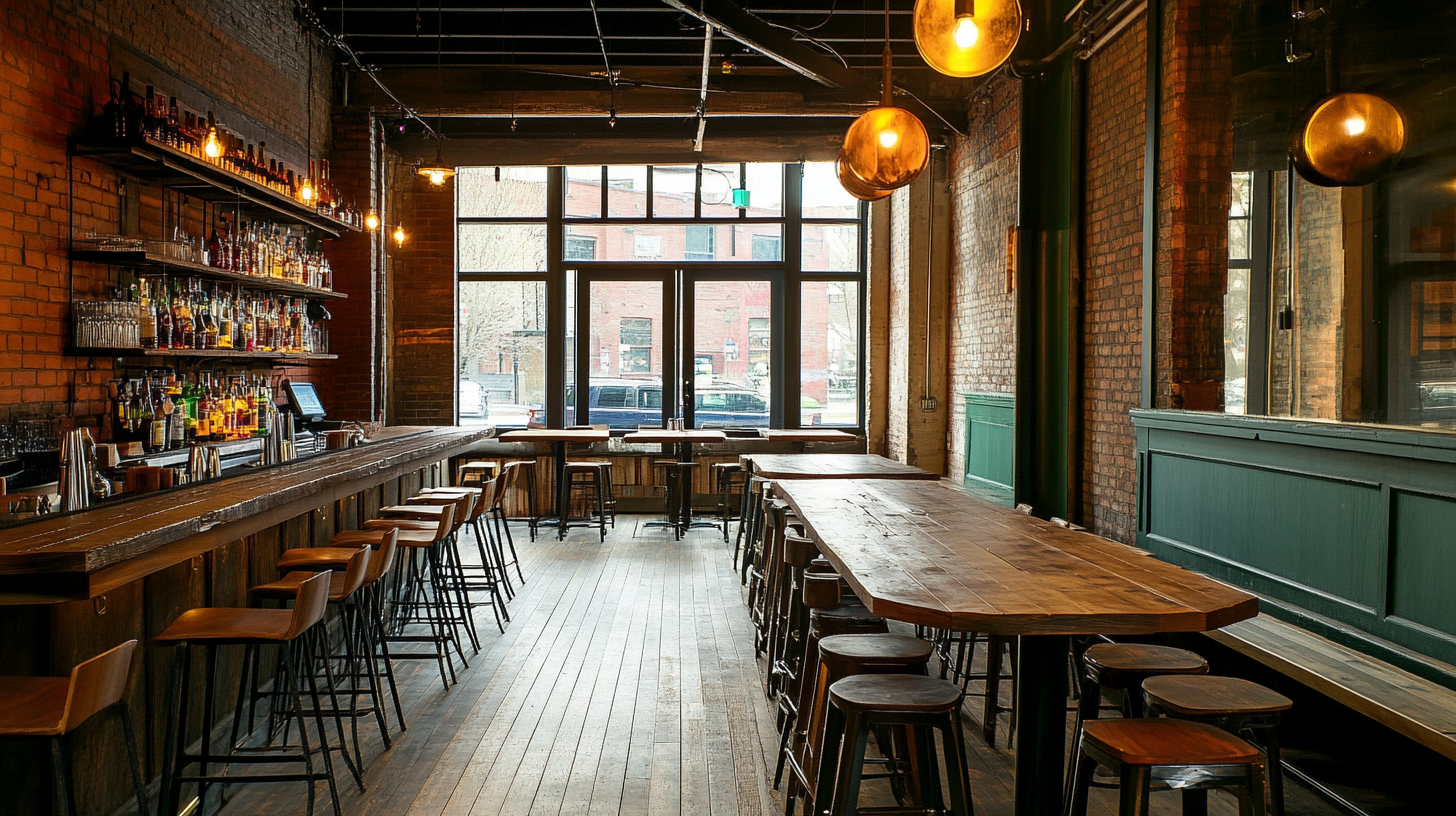As the global marketplace continues to evolve, the demand for quality wood restaurant tables has become a focal point for both manufacturers and restaurateurs alike. Recent reports indicate that the U.S. wood furniture market, valued at approximately $24 billion in 2022, is projected to experience steady growth, thanks in part to the increasing preference for sustainable and aesthetically pleasing dining environments. Despite the challenges posed by U.S.-China trade tariffs, which have affected numerous industries, Chinese manufacturers have remarkably managed to see an uptick in production and export of wooden furniture, including restaurant tables. This resilience not only highlights the adaptability of the wood furniture sector but also reflects the broader consumer trend favoring high-quality materials in restaurant settings. As businesses navigate these changing market dynamics, understanding the interplay between tariffs and product quality becomes essential for ensuring competitive advantage in the hospitality industry.

The US-China trade tensions have created a ripple effect across various industries, and the wood furniture market is no exception. As tariffs on imported goods have increased, manufacturers and retailers face mounting pressures. The elevated costs associated with tariffs on Chinese wood products have led to increased prices for consumers, challenging the demand for high-quality wooden tables in restaurants and homes alike. This shift forces businesses to reassess their supply chains, considering local sourcing or alternative international suppliers to mitigate cost increments.
Furthermore, the changing landscape has intensified the competition between domestic and foreign producers. While some domestic manufacturers are capitalizing on this opportunity by promoting locally sourced products, others struggle to keep pace with price-sensitive consumers who are now more discerning about quality and cost. Understanding these dynamics is essential for restaurant owners and furniture retailers looking to navigate the complexities of a tariff-impacted market. The ability to adapt quickly to changing consumer preferences and sourcing challenges will be critical for success in this evolving industry.
This chart illustrates the average price of wood restaurant tables over several key periods impacted by tariffs. As seen, there has been a consistent increase in prices post-tariff, reflecting the challenges faced by the wood furniture market.
The rise of Chinese manufacturers in the quality wood restaurant table market has become increasingly significant, especially as trade barriers and tariffs create new dynamics in the global supply chain. According to a report by the American Forest & Paper Association, U.S. tariffs on imported wooden products have driven up costs, compelling many restaurateurs to seek out manufacturers that can provide high-quality options at competitive prices. Chinese manufacturers are stepping in, leveraging lower production costs and robust supply chains to meet this demand.
Tip: When considering Chinese manufacturers, ensure to analyze their certification standards and customer reviews. This ensures you’re sourcing high-quality wood tables that not only meet your aesthetic standards but also comply with sustainability guidelines.
The increasing demand for quality wood tables is also leading to innovative designs and sustainable practices from these manufacturers. Reports indicate that approximately 30% of U.S. restaurants are now prioritizing eco-friendly materials, pushing Chinese suppliers to adapt their offerings accordingly. This trend not only benefits the environment but also caters to a growing demographic of environmentally conscious consumers.
Tip: Consider discussing your sustainability goals with potential suppliers to find partners that align with your values. Engaging with manufacturers who prioritize sustainability can enhance your brand's reputation and attract a broader customer base.
| Country | Average Price per Table (USD) | Market Share (%) | Tariff Rate (%) | Quality Rating (1-5) |
|---|---|---|---|---|
| China | 300 | 35 | 25 | 4 |
| USA | 500 | 45 | 10 | 5 |
| Vietnam | 320 | 15 | 15 | 4 |
| Italy | 600 | 5 | 20 | 5 |
| Canada | 550 | 20 | 12 | 4 |
As the restaurant industry evolves, so too does consumer demand for quality furnishings, particularly wooden tables. A recent report from IBISWorld highlights that the U.S. restaurant furniture market is projected to grow at an annual rate of 5.3% through 2025. This increase signals a significant shift towards prioritizing high-quality materials over cost-cutting measures. Restaurateurs are increasingly recognizing that premium furniture not only enhances the dining experience but also improves the overall aesthetic appeal of their establishments, catering to a discerning clientele that values craftsmanship and sustainability.
Furthermore, a survey conducted by the National Restaurant Association indicated that 78% of diners believe that the ambiance of a restaurant is enhanced by quality furniture. This sentiment is driving restaurants to invest in durable, stylish wood tables that can withstand daily wear and tear while still offering visual appeal. As sustainability becomes a key factor in consumer choices, reports from the Forest Stewardship Council show that 66% of consumers are willing to pay more for sustainably sourced materials. This trend further reinforces the idea that high-quality wooden tables are not merely an investment in functionality but are also aligned with the values of modern diners.

In the ever-evolving market of restaurant furnishings, sourcing quality wood tables has become a critical aspect for restaurateurs seeking to attract and retain customers. With rising tariffs impacting wood imports, restaurants must adopt innovative strategies to ensure they acquire durable and aesthetically pleasing tables without overspending.
One effective tip is to build strong relationships with local wood suppliers. Not only does this help in securing better prices, but it also supports the community and reduces transportation costs. Consider collaborating with artisans who can craft bespoke furniture tailored to your restaurant's theme, ensuring uniqueness and higher quality.
Additionally, exploring alternative materials or reclaimed wood can be another avenue for sourcing tables. Reclaimed wood not only offers a rustic charm but also provides an environmentally friendly option that appeals to the eco-conscious diner. Restaurants can also look into bulk purchasing agreements or engage in group buying with other establishments to lower costs further while maintaining quality standards. By implementing these strategies, restaurants can navigate the complexities of the market, ensuring they furnish their establishments effectively and stylishly.
In the furniture industry, tariffs can significantly impact the availability and pricing of quality wood restaurant tables. As businesses navigate these changes, adapting to both tariff shifts and evolving market demands is crucial for success. Retailers and manufacturers must monitor trade policies closely, understanding that fluctuations can affect not only costs but also consumer behavior.
**Tip 1:** Stay informed about current and upcoming tariff regulations that could impact the wood supply chain. Regularly check government announcements and trade associations for updates. This knowledge allows businesses to strategize effectively and mitigate potential disruptions.
Moreover, the demand for high-quality wood restaurant tables continues to grow, as consumers increasingly prioritize sustainability and craftsmanship. Shifting market preferences necessitate that companies not only adjust their sourcing but also enhance their product offerings.
**Tip 2:** Invest in market research to understand current trends and customer preferences. By gathering insights into what consumers value—such as eco-friendly materials and unique designs—businesses can tailor their products to meet these demands, ensuring they remain competitive in a changing landscape.

©2024 Pine Vista LLC, DBA Design Manufacturing Group. All Rights Reserved.



©2024 Pine Vista LLC, DBA Design Manufacturing Group. All Rights Reserved.
